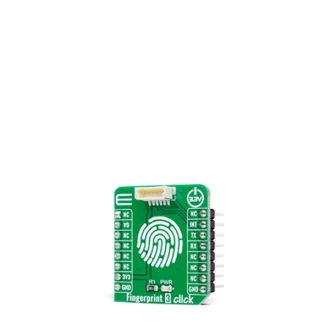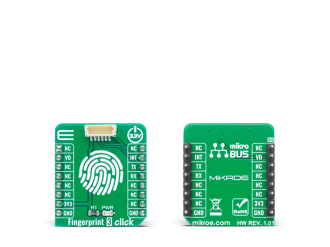
We strongly encourage users to use Package manager for sharing their code on Libstock website, because it boosts your efficiency and leaves the end user with no room for error. [more info]

Rating:
Author: MIKROE
Last Updated: 2020-09-25
Package Version: 1.0.0.0
mikroSDK Library: 1.0.0.0
Category: Fingerprint
Downloaded: 3168 times
Not followed.
License: MIT license
Fingerprint 3 Click is a compact add-on board that allows users to secure its projects with a biometric all-in-one optical fingerprint sensor that will make fingerprint detection and verification super simple.
Do you want to subscribe in order to receive notifications regarding "Fingerprint 3 click" changes.
Do you want to unsubscribe in order to stop receiving notifications regarding "Fingerprint 3 click" changes.
Do you want to report abuse regarding "Fingerprint 3 click".


Library Description
The library covers all the necessary functions to control Fingerprint 3 Click board. A library performs the communication with the device via UART interface.
Key functions:
void fingerprint3_parser_rsp ( fingerprint3_rsp_t *response ) - Response parser function.uint8_t fingerprint3_byte_ready ( void ) - Check for new byte received.void fingerprint3_uart_write ( uint8_t *tx_data, uint8_t n_bytes ) - Uart write function.Examples description
The application is composed of three sections :
void application_task ( )
{
if ( fingerprint3_finger_indicator( ) == FINGERPRINT3_DETECT_FINGER )
{
fingerprint3_buf_clear( );
mikrobus_logWrite( "---------------------------------", _LOG_LINE );
mikrobus_logWrite( " >>> Verification in progress... ", _LOG_LINE );
Delay_ms( 2000 );
fingerprint3_uart_write( &gen_img[ 0 ], 12 );
Delay_ms( 500 );
fingerprint3_parser_rsp( &rsp );
Delay_ms( 100 );
if ( rsp.confirm_code == FINGERPRINT3_OK )
{
fingerprint3_uart_write( &img_2_tz_2[ 0 ], 13 );
Delay_ms( 500 );
fingerprint3_buf_clear( );
}
fingerprint3_uart_write( ®_model[ 0 ], 12 );
Delay_ms( 100 );
fingerprint3_buf_clear( );
fingerprint3_uart_write( &fingerprint_match[ 0 ], 12 );
Delay_ms( 500 );
fingerprint3_parser_rsp( &rsp );
fingerprint3_display_match_score( );
Delay_ms( 3000 );
mikrobus_logWrite( " >>> Comparing Fingerprints <<< ", _LOG_LINE );
mikrobus_logWrite( "- - - - - - - - - - - - - - - - -", _LOG_LINE );
mikrobus_logWrite( " Place your finger on the sensor ", _LOG_LINE );
}
else
{
fingerprint3_uart_write( &aura_led_config_purple[ 0 ], 16 );
Delay_ms( 2000 );
fingerprint3_buf_clear( );
}
}
void fingerprint3_display_rsp ( void ) - Display response function.void fingerprint3_display_match_score ( void ) - Display match score function.void log_write ( uint8_t *str_buf, uint8_t str_type ) - Wrapper mikrobus_logWrite for driver function.void byte_to_str ( uint8_t byte_buf, uint8_t *log_text ) - Wrapper ByteToStr for driver function.void byte_to_hex ( uint8_t byte_buf, uint8_t *log_text ) - Wrapper ByteToHex for driver function.void long_word_to_hex ( uint32_t long_word_buf, uint8_t *log_text ) - Wrapper LongWordToHex for driver function.Other mikroE Libraries used in the example:
Additional notes and informations
Depending on the development board you are using, you may need USB UART click, USB UART 2 click or RS232 click to connect to your PC, for development systems with no UART to USB interface available on the board. The terminal available in all MikroElektronika compilers, or any other terminal application of your choice, can be used to read the message.